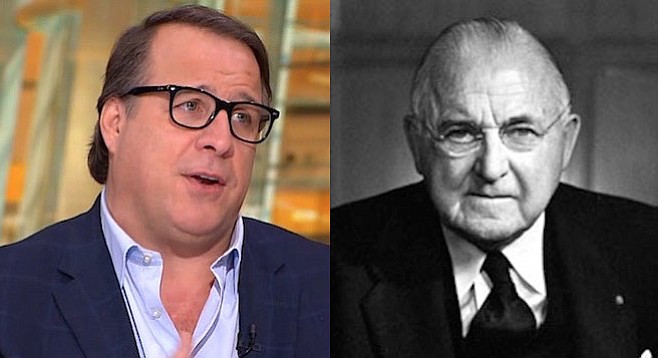 Facebook
Facebook
 X
X
 Instagram
Instagram
 TikTok
TikTok
 Youtube
Youtube

Just how much does newspaper giant Gannett Co. want to own the downtrodden dailies of tronc, proprietor of the San Diego Union-Tribune?
Enough to pay a minor king’s ransom, based on the latest news out of Wall Street, where tronc shares are soaring on word from media blogger Ken Doctor that Gannett has again upped its bid for the assets of tronc, this time to "the mid-$18-a-share range."

"At the $18-plus price, Gannett would have raised its price by more than 20% above its second bid. It delivered that bid of $15 quite publicly in May," notes Doctor. "The May bid in turn represented a further 22% increase from Gannett’s first offer of $12.25 in April."
But that, says Doctor, is not enough for tronc chieftain Michael Ferro, the Midwest wheeler-dealer who grabbed control of the company earlier this year. He may demand upwards of $25 a share to turn over the keys to the bedraggled kingdom.
Even at that exorbitant price, Doctor maintains, "the acquisition marks the biggest win in Gannett’s strategy since it was spun off as a newspaper company from the larger Gannett media empire."
The secret, newspaper watchers say, is Gannett's projected ability to "roll up" the entire industry into a giant virtual monopoly, similar to Blockbuster Video, which ultimately went broke.
"It only works if you keep buying,” Doctor quoted one newspaper-industry executive as saying.
If that sounds like something akin to a Ponzi scheme, it is, note longtime observers of the not-so-slowly imploding newspaper industry.
During Gannett's July 27 earnings call for the second quarter, chairman and CEO Bob Dickey acknowledged, "Advertising revenue was down roughly 10 percent year-to-year on a same-property basis," and "Print circulation volume was off roughly 9 percent daily and 'a little less' on Sundays," according to a Poynter Institute report.
Still, Dickey was upbeat about his acquisition strategy. "We are bullish that local market expansion makes sense."
But what is ostensibly good for Gannett isn't necessarily good for the readers and the legions of staffers at its benighted papers.
Last December, the company announced what it calls the USA Today Network, a mashup of content generated by its papers in "92 local markets" and the firm's national daily USA Today.
"The brands of its local newspapers and their affiliated digital properties will be retained and used as the primary marketing vehicle," Gannett reported.
"USA TODAY Network will serve as 'the endorser sub-brand,' the company said. The local news properties will no longer identify themselves as Gannett properties but rather as USA TODAY Network properties."
Critics say that's code for more downsizing and lost jobs through relentless consolidation. One recent example: on July 20, the company revealed that it was closing its Corpus Christi, Texas, "editing and design center" and moving the work to a similar operation in Phoenix, Arizona, affecting 42 employees.
"Readers will receive the same high-quality newspapers they currently receive," reported the Gannett-owned Corpus Christi Caller-Times.
Similar moves have already happened in San Diego under tronc ownership, with printing of the U-T discontinued here and relocated north to the tronc-owned Los Angeles Times and a small bevy of editorial workers and photographers being laid off just last week.
The latest firings have contributed to speculation that the U-T's presence in San Diego will ultimately shrink to a skeletal local staff, with most work being done in L.A.
Even if the latest proposed deal between Gannett and tronc is finally done, experience of the past two years shows that the tangled ownership tale that has cost San Diego its locally owned daily newspaper may be far from over.
Doctor speculates that tronc's Hollywood star-struck Ferro could seek to hold on to the Los Angeles Times, to which the San Diego U-T is now so tightly tethered that it would likely die if taken off L.A. life support.
And any Gannett takeover — subject to anti-trust review by the U.S. government — might not close until February of next year, leaving the U-T to continue to twist slowly in an uncertain wind.


Just how much does newspaper giant Gannett Co. want to own the downtrodden dailies of tronc, proprietor of the San Diego Union-Tribune?
Enough to pay a minor king’s ransom, based on the latest news out of Wall Street, where tronc shares are soaring on word from media blogger Ken Doctor that Gannett has again upped its bid for the assets of tronc, this time to "the mid-$18-a-share range."

"At the $18-plus price, Gannett would have raised its price by more than 20% above its second bid. It delivered that bid of $15 quite publicly in May," notes Doctor. "The May bid in turn represented a further 22% increase from Gannett’s first offer of $12.25 in April."
But that, says Doctor, is not enough for tronc chieftain Michael Ferro, the Midwest wheeler-dealer who grabbed control of the company earlier this year. He may demand upwards of $25 a share to turn over the keys to the bedraggled kingdom.
Even at that exorbitant price, Doctor maintains, "the acquisition marks the biggest win in Gannett’s strategy since it was spun off as a newspaper company from the larger Gannett media empire."
The secret, newspaper watchers say, is Gannett's projected ability to "roll up" the entire industry into a giant virtual monopoly, similar to Blockbuster Video, which ultimately went broke.
"It only works if you keep buying,” Doctor quoted one newspaper-industry executive as saying.
If that sounds like something akin to a Ponzi scheme, it is, note longtime observers of the not-so-slowly imploding newspaper industry.
During Gannett's July 27 earnings call for the second quarter, chairman and CEO Bob Dickey acknowledged, "Advertising revenue was down roughly 10 percent year-to-year on a same-property basis," and "Print circulation volume was off roughly 9 percent daily and 'a little less' on Sundays," according to a Poynter Institute report.
Still, Dickey was upbeat about his acquisition strategy. "We are bullish that local market expansion makes sense."
But what is ostensibly good for Gannett isn't necessarily good for the readers and the legions of staffers at its benighted papers.
Last December, the company announced what it calls the USA Today Network, a mashup of content generated by its papers in "92 local markets" and the firm's national daily USA Today.
"The brands of its local newspapers and their affiliated digital properties will be retained and used as the primary marketing vehicle," Gannett reported.
"USA TODAY Network will serve as 'the endorser sub-brand,' the company said. The local news properties will no longer identify themselves as Gannett properties but rather as USA TODAY Network properties."
Critics say that's code for more downsizing and lost jobs through relentless consolidation. One recent example: on July 20, the company revealed that it was closing its Corpus Christi, Texas, "editing and design center" and moving the work to a similar operation in Phoenix, Arizona, affecting 42 employees.
"Readers will receive the same high-quality newspapers they currently receive," reported the Gannett-owned Corpus Christi Caller-Times.
Similar moves have already happened in San Diego under tronc ownership, with printing of the U-T discontinued here and relocated north to the tronc-owned Los Angeles Times and a small bevy of editorial workers and photographers being laid off just last week.
The latest firings have contributed to speculation that the U-T's presence in San Diego will ultimately shrink to a skeletal local staff, with most work being done in L.A.
Even if the latest proposed deal between Gannett and tronc is finally done, experience of the past two years shows that the tangled ownership tale that has cost San Diego its locally owned daily newspaper may be far from over.
Doctor speculates that tronc's Hollywood star-struck Ferro could seek to hold on to the Los Angeles Times, to which the San Diego U-T is now so tightly tethered that it would likely die if taken off L.A. life support.
And any Gannett takeover — subject to anti-trust review by the U.S. government — might not close until February of next year, leaving the U-T to continue to twist slowly in an uncertain wind.
Comments